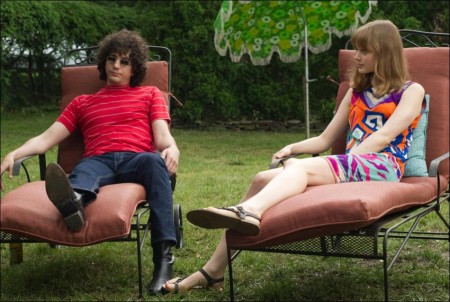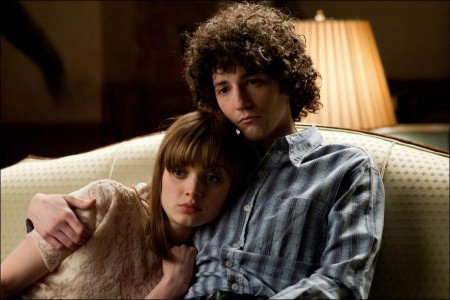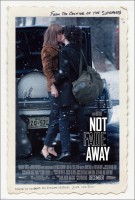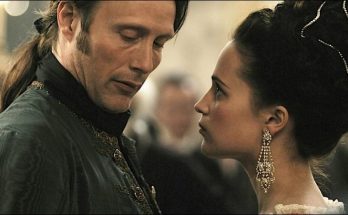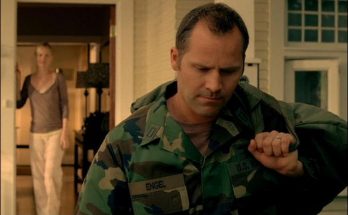On a train, Keith and Mick chat about the blues and the Rolling Stones are born. Douglas and Joe chat in front of a New Jersey music store, and a band is born: as Douglas’s sister tells us, it’s one of many that don’t make it. We follow Douglas from high school (1963-64), when he sees himself as a loser, into the band, playing drums and singing backup – then as the front man.
There are tensions, a breakup, an audition in front of a major player, and decisions. Douglas pursues Grace, a country-club gal with hip sensibilities who believes in him. There’s also his father, working class, wanting Douglas to apply himself as he watches his own life fill with regrets.
Not Fade Away is a 2012 drama film and the directorial debut of The Sopranos creator David Chase. It stars John Magaro, Jack Huston, Will Brill, Brahm Vaccarella, Bella Heathcote, Molly Price, Meg Guzulescu, Dominique McElligott, Gregory Perri, Christopher McDonald and Brad Garrett. It was released on December 21, 2012.
Film Review for Not Fade Away
One of the many attributes that made The Sopranos such epically great American television was its idiosyncratic use of music. So it’s both unsurprising and entirely fitting that for his first feature, the creator of that series, David Chase, has made a movie not only stacked with inspired music choices, but fundamentally about the formative influence of music on a generation.
It’s also appropriate that Not Fade Away takes its title from a song popularized by Buddy Holly and by The Rolling Stones. This deeply personal reflection on growing up in the 1960s captures a shift in rock‘n’ roll that had its roots in the transition between those artists – a revolution that continued rippling through the broader culture in the decade that followed, in ways both concrete and intangible.
The film may be too meandering for mainstream acceptance, but its focus will make the Paramount Vantage release connect directly with many baby boomers. It’s also a warm, funny, poignant scrapbook that evokes a spirit of youth still relatable in later eras. (Watch the trailer here.)
Movies about bands such as The Commitments, Backbeat, That Thing You Do!, Control and The Runaways tend most often to chronicle the formation, the early struggles or the rise and fall. The efforts of a group of friends in the comfortable New Jersey suburbs to break out of their garages and into the music industry are a large part of Chase’s film. But that story is more of a canvas for a gently reflective coming-of-age drama, providing a vague kinship with Cameron Crowe’s Almost Famous.
More than that, however, Not Fade Away is a richly contextualized snapshot of changing social dynamics, examining the conflict between traditional values of security and stability and the restless hunger for creative fulfillment. Politics and the civil rights movement are part of the movie’s backdrop, but its depiction of the fumbling search for personal and artistic freedom is shaped as much by pop culture. Books, movies, television and especially music supply the juice here, dipping into everything from The Twilight Zone to Antonioni.
Drawing directly from Chase’s youthful experience as a drummer in a Garden State band, the central character is Douglas (John Magaro). He plays covers of Bo Diddley, the Stones and the Kinks at local parties in a group led by his friends Gene (Jack Huston) and Wells (Will Brill). While Douglas shoots dreamy-eyed glances at high-school beauty Grace (Bella Heathcote), she seems to be more jock-inclined. That changes when lead vocalist Gene has to skip a gig after swallowing a lit joint and Douglas steps in, proving himself the superior singer.
Along with ferment in the band, the film also follows Douglas’ uneasy relationship with his blue-collar Italian-American family, typified by a hilariously tense Christmas dinner. Magaro looks at times uncannily like a young Bob Dylan, and when he comes home from college with a mop of curls, a pea coat and Cuban-heeled boots, his depressive mother (Molly Price) shakes her head in disgust while his father, Pat (James Gandolfini), says he looks like he just got off the boat at Ellis Island.
When Pat is diagnosed with cancer the pull is felt to bring Douglas back into the family fold. But Chase is less interested in that conflict than in the wistfulness with which hardass Pat comes to view his son’s exploratory steps toward self-discovery, and the regrets of his own life. Gandolfini plays these realizations with affecting subtle strokes, notably in one particularly lovely moment set to the unexpected strains of “Bali Ha’i” from South Pacific.
It might be argued that Chase dilutes his focus by digressing into the troubles of Grace’s well-heeled conservative family concerning her unstable, artsy sister (Dominique McElligott). But this serves to push Grace and Douglas back together after a rift, and also to illustrate more tragic manifestations of the WWII generation’s fear of change.
There’s a loose, collage quality to the storytelling, with extended intimate exchanges interspersed among short scene fragments. This suggests that while Chase is moving into features, he is not abandoning the unhurried pace and ample breathing room of long-form television. It’s a welcome unconventional touch that the guiding voiceover – for once used with refreshing economy – doesn’t come from the obvious source of Douglas, but from his kid sister (Meg Guzulescu). She observes from the sidelines until stepping into center-screen in a wonderfully odd coda that hints at the next transition to come.
The film is more driven by tone and texture than performance, but the characters are all sharply drawn with an affectionate embrace of their flaws, among them Huston’s resentful egomaniac Gene, and Brill’s philosophizing Wells. Magaro plays the rebellious side of Douglas as well as his burgeoning sense of self in appealing low-key mode. And Australian import Heathcote, who showed promise in Dark Shadows, reveals a more immediately captivating delicacy here.
Cinematographer Eigil Bryld provides a deft balance of grit and gloss in the visuals, matched by the scrupulous yet understated attention to period detail in Ford Wheeler’s production design and Catherine Marie Thomas’ costumes. Some images will make anyone who lived through the era laugh out loud, such as a room full of girls languidly puffing on cigarettes, staring transfixed and intoxicated at a B&W television as Mick Jagger sings “I Just Want to Make Love to You” on Hollywood Palace.
Chase’s Sopranos paisan Steven Van Zandt serves as music producer, curating an eclectic selection of vintage tracks that rigorously avoids the obvious. (The deployment of Tracy Nelson’s haunting vocals on Mother Earth’s “Down So Low” is genius.) Van Zandt also wrote a terrific song titled “The St. Valentine’s Day Massacre” to serve as Douglas and Co.’s first foray into original material. It has more than enough kick to feed the melancholy undertow when their career plans don’t pan out.
Not Fade Away (2012)
Directed by: David Chase
Starring: John Magaro, Jack Huston, Will Brill, Brahm Vaccarella, Bella Heathcote, Molly Price, Meg Guzulescu, Dominique McElligott, Gregory Perri, Christopher McDonald, Brad Garrett
Screenplay by: David Chase
Production Design by: Ford Wheeler
Cinematography by: Eigil Bryld
Film Editing by: Sidney Wolinsky
Costume Design by: Catherine Marie Thomas
Set Decoration by: Cherish M. Hale
Art Direction by: Henry Dunn
MPAA Rating: R for pervasive language, some drug use and sexual content.
Distributed by: Paramount Vantage
Release Date: December 21, 2012
Hits: 67
